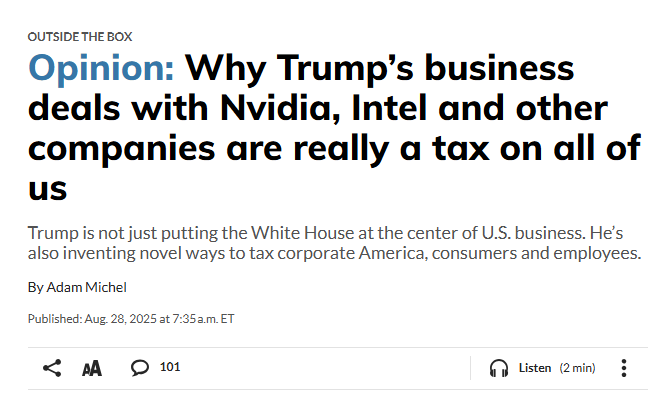Nvidia, Intel, and Trump’s Backdoor Tax Hikes
Trump is not just putting the White House at the center of U.S. business. He’s also inventing novel ways to tax corporate America, consumers and employees.
This op-ed was originally published at MarketWatch on August 28, 2025.
The buzz in Washington is that America is marching toward state-directed capitalism. President Donald Trump’s recent deals with Nvidia and Intel are prime examples: The government picks corporate winners and dictates market terms. This corporatism is a worrying trend. But most commentary misses a peculiar and revealing twist: Each of Trump’s deals requires hefty payments to the U.S. Treasury.
Trump is not just putting the White House at the center of U.S. business. He’s also inventing novel ways to tax corporate America, its consumers and employees. This speaks to a deeper problem: the president’s fixation on novel revenue sources. It’s bad economics, bad tax policy, legally dubious, and won’t make a meaningful dent in the federal budget deficit.
The conventional critique of these industrial deals is straightforward. When the government makes multibillion-dollar arrangements with chipmakers or foreign steel giants, it crowds out market discipline and turns competition into political patronage. Market entrepreneurs reorient their innovations toward securing and maintaining political access rather than innovating products designed to meet consumer needs.
But what stands out in the reported arrangements with Nvidia, Advanced Micro Devices, Nippon Steel, and Intel is not just the industrial policy. It’s the payments demanded by the U.S. Treasury. They aren’t the normal direct subsidies, loan guarantees or tax credits. They are bespoke payments with murky terms.
It’s a pattern. Trump has floated similar novel revenue streams before: new fees based on patent value, one-off levies tied to immigration, and, most notably, tariffs as a substitute for the income tax.
The federal government doesn’t lack ways to raise revenue. Washington already extracts more than 17% of GDP in a typical year. What Trump is chasing is novelty: creating quirky,made-for-headlines revenue sources that he can claim are paid by someone other than his constituents.
But novelty isn’t a virtue in tax policy. Sound tax systems require neutrality, inflicting as little distortion on economic decision-making as possible. Trump’s improvised taxes do the opposite.
The recent industrial deals illustrate the risks of novelty. When a president can dictate that leading American firms must pay the Treasury a couple of billion dollars in exchange for merger approval, market access, or other regulatory relief, tax policy becomes indistinguishable from extortion.
Investors no longer ask, “Where will my investment earn the highest return?” They ask, “What cut will Washington demand, and how do I stay in its good graces?” That’s not capitalism. It’s corporatism with a surtax.
The bevy of deals for revenue sharing, government equity stakes, and nebulous “golden shares” might raise a few billion dollars a year. Compare that to the roughly $7 trillion the government spends each year and the $3 trillion annual deficit we are projected to have by 2032, if Congress continues on its current policy path.
Trump’s biggest new revenue source is from tariffs, which the administration has championed as raising $150 billion in the past six months. But headline figures can overstate revenue gains that don’t take into account accompanying reductions in other revenue sources and market adjustments that lead to less total trade.
Two professors recently estimated that under optimistic assumptions, the maximum annual U.S. tariff revenue is about $500 billion. Trump’s actual tariffs are projected to raise less than a third of that. But even these substantial tax hikes are small in comparison to America’s fiscal problem.
The federal government borrowed $1.8 trillion last year to sustain high spending while keeping taxes relatively low. If spending continues unchecked, the U.S. will inevitably grow into a European-sized government. That comes with real costs.
The only sustainable way to fund big government is through high taxes on everyone, rich, middle-class and poor alike. Europe shows this reality: The average worker there pays about $12,000 more each year through high value-added taxes, higher payroll taxes and higher income taxes that reach deep into the middle class.
No amount of creative arithmetic changes basic fiscal facts. And no new market access surtax or golden share of corporate profits will raise enough revenue to defuse the debt bomb Congress has set to explode.
The real fix is the old-fashioned one: Restrain spending, broaden the tax base and let free markets allocate resources. No novel revenue sources or market manipulation can substitute.


